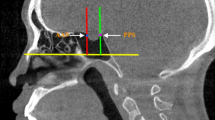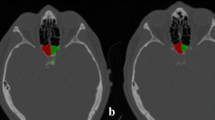Abstract
Purpose
We aimed to determine the position and size of the sphenoid sinus (SS) in our study and compare the results of the measurements relative to age, gender, and the presence of pituitary adenoma using multidetector computerized tomography (MDCT).
Methods
We retrospectively evaluated the paranasal sinus computerized tomography (CT) images of 200 individuals (age range of all the individuals 4–84 years; 101 females, 99 males; age range of individuals with pituitary adenoma 15–63 years; 15 females, 9 males) with 24 pituitary adenomas. The shape of SS were identified and classified, volume were measured by MDCT also for individuals with pituitary adenoma.
Results
It was determined that the volume averages were significantly affected by the type of SS. Among all the individuals studied, the sellar type of SS was most frequently observed (41.5%), followed by the postsellar type (38.5%), and the least observed was the presellar type (9%). The volume of the SS is bigger in males than females although the volume is not affected by the presence of pituitary adenomas. The development of the SS continues until the age of nine.
Conclusion
The morphology and morphometry of the SS show individual differences. These anatomic variations are important for decision making and application for surgical interventions (especially transsphenoidal surgery).



Similar content being viewed by others
References
Som PM, Lawson W, Fatterparker GM et al (2011) Embryology, anatomy, physiology and imaging of the sinonasal cavities. In: Som PM, Curtin HD (eds) Head and neck imaging, 5th edn. Elsevier Health Sciences, St. Louis, pp 99–141
Reittner P, Doerfler O, Goritschnig T et al (2001) Magnetic resonance imaging patterns of the development of the sphenoid sinus: a review of 800 patients. Rhinology 39(3):121–124
Leclerc JE, Leclerc JT (2009) Sphenoid sinus development in choanal atresia. Int J Pediatr Otorhinolaryngol 73(12):1746–1750
Scuderi AJ, Harnsberger HR, Boyer RS (1993) Pneumatization of the paranasal sinuses: normal features of importance to the accurate interpretation of CT scans and MR images. AJR Am J Roentgenol 160(5):1101–1104. https://doi.org/10.2214/ajr.160.5.8470585
Jang YJ, Kim SC (2000) Pneumatization of the sphenoid sinus in children evaluated by magnetic resonance imaging. Am J Rhinol 14(3):181–185
Park IH, Song JS, Choi H et al (2010) Volumetric study in the development of paranasal sinuses by CT imaging in Asian: a pilot study. Int J Pediatr Otorhinolaryngol 74(12):1347–1350. https://doi.org/10.1016/j.ijporl.2010.08.018
Yonetsu K, Watanabe M, Nakamura T (2000) Age-related expansion and reduction in aeration of the sphenoid sinus: volume assessment by helical CT scanning. AJNR Am J Neuroradiol 21(1):179–182
Tan HK, Ong YK, Teo MS et al (2003) The development of sphenoid sinus in Asian children. Int J Pediatr Otorhinolaryngol 67(12):1295–1302
Spaeth J, Krugelstein U, Schlondorff G (1997) The paranasal sinuses in CT-imaging: development from birth to age 25. Int J Pediatr Otorhinolaryngol 39(1):25–40. https://doi.org/10.1016/S0165-5876(96)01458-9
Lake MG, Krook LS, Cruz SV (2013) Pituitary adenomas: an overview. Am Fam Phys 88(5):319–327
Kayalioglu G, Erturk M, Varol T (2005) Variations in sphenoid sinus anatomy with special emphasis on pneumatization and endoscopic anatomic distances. Neurosciences 10(1):79–84
Adibelli ZH, Songu M, Adibelli H (2011) Paranasal sinus development in children: a magnetic resonance imaging analysis. Am J Rhinol Allergy 25(1):30–35. https://doi.org/10.2500/ajra.2011.25.3552
Banna M, Olutola PS (1983) Patterns of pneumatization and septation of the sphenoidal sinus. J Can Assoc Radiol 34(4):291–293
Hamid O, Fiky LE, Hassan O et al (2008) Anatomic variations of the sphenoid sinus and their impact on trans-sphenoid pituitary surgery. Skull base 18(1):9–15. https://doi.org/10.1055/s-2007-992764
Sheikh BY, Zahran MF (2006) Radiological anatomy of the sella turcica and sphenoid sinus. Pan Arab J Neurosurg 10(1):46–49
Guldner C, Pistorius SM, Diogo I et al (2012) Analysis of pneumatization and neurovascular structures of the sphenoid sinus using cone-beam tomography (CBT). Acta Radiol 53(2):214–219. https://doi.org/10.1258/ar.2011.110381
Chauhan P, Kalra S, Mongia S et al (2014) Morphometric analysis of sella turcica in North Indian population: a radiological study. Int J Res Med Sci 2(2):521–526. https://doi.org/10.5455/2320-6012.ijrms20140529
Alkofide EA (2007) The shape and size of the sella turcica in skeletal Class I, Class II, and Class III Saudi subjects. Eur J Orthod 29(5):457–463. https://doi.org/10.1093/ejo/cjm049
Gibelli D, Cellina M, Gibelli S et al (2018) Volumetric assessment of sphenoid sinuses through segmentation on CT scan. Surg Radiol Anat 40(2):193–198. https://doi.org/10.1007/s00276-017-1949-1
Cohen O, Warman M, Fried M et al (2018) Volumetric analysis of the maxillary, sphenoid and frontal sinuses: a comparative computerized tomography based study. Auris Nasus Larynx 45(1):96–102. https://doi.org/10.1016/j.anl.2017.03.003
Lu Y, Pan J, Qi S et al (2011) Pneumatization of the sphenoid sinus in Chinese: the differences from Caucasian and its application in the extended transsphenoidal approach. J Anat 219(2):132–142. https://doi.org/10.1111/j.1469-7580.2011.01380
Dal Secchi MM, Dolci RLL, Teixeira R et al (2018) An analysis of anatomic variations of the sphenoid sinus and its relationship to the internal carotid artery. Int Arch Otorhinolaryngol 22(2):161–166. https://doi.org/10.1055/s-0037-1607336
Rhoton AL Jr, Hardy DG, Chambers SM (1979) Microsurgical anatomy and dissection of the sphenoid bone, cavernous sinus and sellar region. Surg Neurol 12(1):63–104
Massoud AF, Powell M, Williams RA et al (1997) Transsphenoidal surgery for pituitary tumours. Arch Dis Child 76(5):398–404
Schipke JD, Cleveland S, Drees M (2018) Sphenoid sinus barotrauma in diving: case series and review of the literature. Res Sports Med 26(1):124–137. https://doi.org/10.1080/15438627.2017.1365292
Li E, Howard MA, Vining EM et al (2018) Visual prognosis in compressive optic neuropathy secondary to sphenoid sinus mucocele: a systematic review. Orbit 37(4):280–286. https://doi.org/10.1080/01676830.2017.1423087
Wiebracht ND, Zimmer LA (2014) Complex anatomy of the sphenoid sinus: a radiographic study and literature review. J Neurol Surg B Skull Base 75(6):378–382. https://doi.org/10.1055/s-0034-1376195
Wada K, Moriyama H, Edamatsu H et al (2015) Identification of Onodi cell and new classification of sphenoid sinus for endoscopic sinus surgery. Int Forum Allergy Rhinol 5(11):1068–1076. https://doi.org/10.1002/alr.21567
Acknowledgements
The authors would like to thank Assistant Professor Neriman Akdam for her work on the statistical analysis.
Funding
This research did not receive any specific Grant from funding agencies in the public, commercial, or not-for-profit sectors.
Author information
Authors and Affiliations
Corresponding author
Ethics declarations
Conflict of interest
None of the authors have a personal conflict of interest to declare.
Ethical approval
All procedures performed in this study involving human participants were in accordance with the ethical standards of the institutional and/or national research committee and with the 1964 Helsinki declaration and its later amendments or comparable ethical standards. Ethical approval (approval number 2016/205) was given by the Non-Intervention Clinical Research Ethics Committee of the Medical Faculty.
Informed consent
A formal informed consent procedure was waived due to the retrospective nature of this study.
Additional information
Publisher's Note
Springer Nature remains neutral with regard to jurisdictional claims in published maps and institutional affiliations.
Rights and permissions
About this article
Cite this article
Pirinc, B., Fazliogullari, Z., Guler, I. et al. Classification and volumetric study of the sphenoid sinus on MDCT images. Eur Arch Otorhinolaryngol 276, 2887–2894 (2019). https://doi.org/10.1007/s00405-019-05549-8
Received:
Accepted:
Published:
Issue Date:
DOI: https://doi.org/10.1007/s00405-019-05549-8




